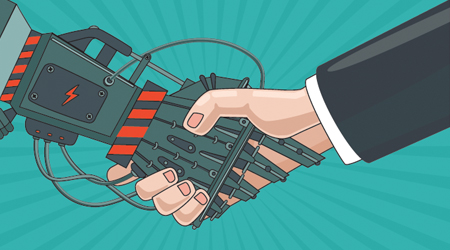
Despite the benefits of robotic cleaning, it has not come without its controversies — the largest of which has to do with replacing the human workforce. But the manufacturers contend that autonomous floor cleaning simply makes janitors more productive, not obsolete. They add janitors will still be needed to fill the water tanks, provide light maintenance and set the programming.
“We are not displacing people,” says Bidell. “In most cases, there is more work for the janitorial staff to perform than there are hours allocated. This is just one time-consuming task taken off their plate.”
McElhattan points out that the industry is already struggling with staff shortages. In wealthy cities such as Singapore or San Francisco, for example, people can’t afford to live on a janitor’s wage. The entry of floor cleaning robots could shore up those losses, as well as provide labor savings.
“I think it’s inevitable that there could be some reduction in the head count of janitors over the next 10 years,” says McElhattan. “There are going to be fewer janitors, but that’s the way tech advancement goes. If [BSCs] can buy a couple of robots and have 125 people, instead of 128, that’s attractive to them.”
Still, few manufacturers dispute robotics’ shiny reliability factor. They say humans are often driven by emotion and are prone to errors. That can lead to unfinished or subpar work — and leave BSCs behind to deal with the consequences.
“As a BSC, I can guarantee that this work gets done,” says Krausenik of the robots. “That’s a powerful statement.”
In addition to helping janitorial staff lighten the load, robotic floor cleaning manufacturers say one of the biggest benefits of robotic technology may have to do with worker safety. Janitors are the third-leading group of workers affected by musculoskeletal disorders due to the repetitive motion of cleaning. Robots could eliminate that factor.
“The injury rate is really high,” says McElhattan. “This technology is bringing solutions that get people out of the dull, dirty and dangerous work environment.”
Limitations … For Now
Currently the machines are relegated to the wide-open spaces seen in big box stores, office buildings, educational facilities and airport terminals. Most of the machines are roughly the same size as current floor care equipment, and thus are not exactly nimble.
Then there’s the problem of navigation.
Though the machines are fine-tuned to stop on a dime for humans and other obstacles, the machines are too large to maneuver in tight or cluttered spaces. Other limitations include those similar to that of manual floor cleaners — battery longevity, water tank fill times and switching out floor pads and other attachments to perform specific cleaning tasks.
Yet, perhaps the biggest barrier lies within the high cost of the equipment. Larger BSCs may be able to afford the machines, but small businesses will likely be kept out of the loop — at least for now.
“These are not Roombas you are going to buy for your home — it’s a $40,000 robot,” says McElhattan. “We believe we have about a 12-month ROI, but if you don’t have $40,000, we’re probably out of range.”
That being said, most BSCs aren’t likely to purchase an entire fleet of robotic floor cleaners, says the team at Sealed Air Diversey Care. The company believes buying even just one robot is worth the labor savings, which is an attractive concept to BSCs. Plus, expenses are sure to come down as the technology continues to improve.
“Our sales and service is constantly working with engineering,” says Mark Klawitter of TASKI-Intellibot technical services for Sealed Air Diversey Care. “We’re not content with where our machines are today.”
Manufacturers say the opportunities for robotics in floor cleaning — and in commercial cleaning in general — are boundless.
“The interest level in the activity in the marketplace regarding robotics is accelerating,” says Bidell. “If you compare potential users to one year ago, it is significantly larger. We believe this trend will continue as we get beyond early adopters, into more of everyday users.”
The robots of today are certainly not the robots of tomorrow.
“Five years from now, we’ll be having a different conversation,” says McElhattan. “Robots may be able to pick up your garbage can, move chairs and vacuum in and out of cubicles.”
Upcoming Robotics Webcast
Cleanlink.com will host the webcast “Robotics: Emerging Technology in the Cleaning Industry” on May 24 at 1 p.m. Eastern. The free webcast will feature a panel of robotic technology providers and explore what the future holds for autonomous equipment.
The discussion will cover current robotic cleaning applications and how the machines fit into today’s cleaning programs. Panel members will also evaluate robots’ benefits and productivity advantages, among other topics.
At the end of the webcast, the panel members will take part in a question-and-answer session with the live audience.
If unable to attend, the archived webcast can be viewed anytime, for free, at www.cleanlink.com/webcasts.
Stephanie S. Beecher is a freelance writer based in Milwaukee. She is a former Associate Editor of Contracting Profits.
Welcome To ‘Smart’ Floor Cleaning Machines

 The Down and Dirty on Cleaning in Virus Season
The Down and Dirty on Cleaning in Virus Season How Surfactant Use is Expanding in Commercial Cleaning
How Surfactant Use is Expanding in Commercial Cleaning Maximize Your Margins: Learn How to Automate Pricing and Track Rebates
Maximize Your Margins: Learn How to Automate Pricing and Track Rebates